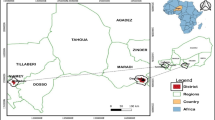Abstract
The diets of fallow deerDama dama (Linnaeus, 1758) were analysed on the basis of the rumen contents of 69 individuals harvested between October and January in two areas of Poland: Iława, where animals are fed artificially in winter and Pszczyna, where almost no winter feeding is applied. The composition of the diet was found to be similar in both areas, with graminoids — as the staple food — accounting for 43.1% in Iława and 45.9% in Pszczyna. Further similarities between the areas were noted in regard to the other main foods eaten, ie the foliage of broadleaved deciduous trees and Scots pine, as well as forbs. Together, these four categories of food accounted for 73.1% and 73.0% of the diet in Iława and Pszczyna, respectively. Browse and bark were eaten in very small amounts, an observation suggesting that the contribution made by fallow deer to overall cervid-induced damage at least in some Polish forests is relatively small. Sample size limitations confined analysis of monthly food composition to the data from Iława only. These revealed graminoids as the major food each month, though shares of the diet ranged between 56.4% in November and 30.3% in January. Maximum levels of consumption of broadleaved deciduous foliage (21.9%) and forbs (10.3%) were recorded in October, and afterwards decreased. In turn, the role of pine foliage share increased from October (7.8%) through January (14.5%). The maximum availability of artificial forage occurred in January and its share in the diet was then as high as 21.2%.
Similar content being viewed by others
References
Boutin S. 1990. Food supplementation experiments with terrestrial verterbrates: patterns, problems, and the future. Canadian Journal of Zoology 68: 203–220.
Bresiński W., Bryliñski R., Kamieniarz R. and Panek M. 2000. [Situation of game in Poland, part 1: Big game]. Łowiec Polski 1: 17–19. [In Polish]
Bruno E. and Apollonio M. 1991. Seasonal variations in the diet of adult male fallow deer in a submediterranean costal area. Revue d’Ecologie (Terra Vie) 46: 349–362.
Caldwell J. F., Chapman D. J. and Chapman N. G. 1983. Observations on the autumn and winter diet of Fallow deer (Dama dama). Journal of Zoology, London 201: 559–563.
Chamrad A. D. and Box T. W. 1964. Point frame for sampling rumen contents. The Journal of Wildlife Management 28: 473–477.
Chapman D. and Chapman N. 1997. Fallow deer. Their history, distribution and biology. Coch-Y-Bonddu Books, Machynlleth: 1–271.
Doenier P. B., DelGiudice G. D. and Riggs M. R. 1997. Effects of winter supplemental feeding on browse consumption by white-tailed deer. Wildlife Society Bulletin 25: 235–243.
Dzięciołowski R. 1969. The quantity, quality and seasonal variation of food resources available to red deer in various environmental conditions of forest management. Forest Research Institute, Warsaw: 1–295.
Faliński J. B. 2001. Phytophenological atlas of the forest communities and species of Białowieża National Park. Phytocoenosis. Archivum Geobotanicum 8: 1–176.
Gębczyńska Z. 1980. Food of the roe deer and red deer in the Białowieża Primeval Forest. Acta Theriologica 25: 487–500.
Gill R. M. A. 1992a. A review of damage by mammals in north temperate forests: 1. Deer. Forestry 65: 145–169.
Gill R. M. A. 1992b. A review of damage by mammals in north temperate forests: 3. Impact on tree and forest. Forestry 65: 363–388.
Gordon I. J. 1989. Vegetation community selection by ungulates on the Isle of Rhum. Journal of Applied Ecology 26: 35–51.
Guillet C., Bergstrom R. and Cederlung G. 1996. Size of winter home range of roe deerCapreolus capreolus in two areas with artificial feeding in Sweden. Wildlife Biology 2: 107–111.
Hoffmann R. R. 1985. Digestive physiology of the deer. Their morphophysiological specialisation and adaptation. Bulletin of Royal Society of New Zeland 22: 393–407.
Jackson J. 1977. The annual diet of the Fallow deer (Dama dama) in the New Forest, Hampshire, as determined by rumen content analysis. Journal of Zoology, London 181: 465–473.
Makkar H. P. S. and Singh B. 1993. Composition, tannin levels and in-sacco dry matter digestibility of fresh and fallen oak (Quercus incana) leaves. Bioresource-Technology 37: 185–187.
Mitani N. 1995. [Foraging behaviour of tame Sika deer on Mt. Tonotake, Tanzawa Mountains]. MSc thesis, University of Tokyo, Tokyo: 1–57. [In Japanese]
Moen A. N. 1973. Wildlife ecology. W. H. Freeman and Company, San Francisco: 1–458.
Ozoga J. J. and Verme L. J. 1982. Physical and reproductive characteristics of a supplementally-fed white-tailed deer herd. The Journal of Wildlife Management 46: 281–301.
Putman R. J., Culpin S. and Thirgood S. J. 1993. Dietary differences between male and female fallow deer in sympatry and in allopatry. Journal of Zoology, London 229: 267–275.
Siuda A., Żurowski W. and Siuda H. 1969. The food of the roe deer. Acta Theriologica 18: 247–262.
StatSoft Inc. 1995. STATISTICA for Windows. Computer program manual. StatSoft, Inc., 2325 East 13th Street, Tulsa, OK.
Verme L. J. and Ozoga J. J. 1980. Effects of diet on growth and lipogenesis in deer fawns. The Journal of Wildlife Management 44: 315–324.
Author information
Authors and Affiliations
Additional information
Associate Editor was Bogumiła Jędrzejewska.
Rights and permissions
About this article
Cite this article
Borkowski, J., Obidziński, A. The composition of the autumn and winter diets in two Polish populations of fallow deer. Acta Theriol 48, 539–546 (2003). https://doi.org/10.1007/BF03192499
Received:
Accepted:
Issue Date:
DOI: https://doi.org/10.1007/BF03192499




